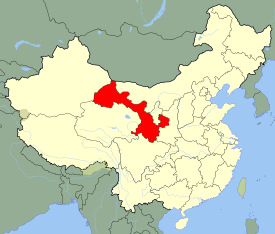Lanzhou
| Lanzhou 兰州 |
|
|---|---|
| — Prefecture-level city — | |
| 兰州市 | |
 |
|
.png) |
|
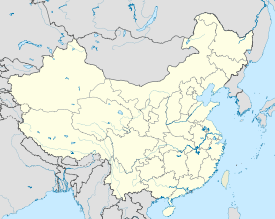 Lanzhou
|
|
| Coordinates: | |
| Country | China |
| Province | Gansu |
| County-level divisions | 8 |
| Government | |
| - Mayor | Yuan Zhanting (袁占亭) |
| - Deputy Mayor | Cai Ming |
| Area | |
| - Total | 13,100 km2 (5,057.9 sq mi) |
| Population (2008) | |
| - Total | 3,310,100 |
| - Density | 252.7/km2 (654.4/sq mi) |
| Time zone | China Standard Time (UTC+8) |
| Postal code | 730000 |
| Area code(s) | 931 |
| License plate prefixes | 甘A |
| GDP (2008) | CNY 84.6 billion |
| - per capita | CNY 25,566 |
| Website | http://www.lz.gansu.gov.cn (Chinese) |
|
Rugosa Rose |
|
| Lanzhou | |||||||||||||||||
|---|---|---|---|---|---|---|---|---|---|---|---|---|---|---|---|---|---|
| Traditional Chinese | 蘭州 | ||||||||||||||||
| Simplified Chinese | 兰州 | ||||||||||||||||
| Literal meaning | elegant state or Capital of Lan | ||||||||||||||||
|
|||||||||||||||||
Lanzhou (simplified Chinese: 兰州; traditional Chinese: 蘭州; pinyin: Lánzhōu; Wade–Giles: Lan-chou; Postal map spelling: Lanchow) is a prefecture-level city and capital of Gansu province in northwestern China.
Contents |
History
Originally in the territory of the Western Qiang peoples, Lanzhou became part of the territory of Qin in the 6th century BC.
In 81 BC, under the Han dynasty (206 BC–220 AD), it became the seat of Jincheng county (xiàn) and later of Jincheng commandery (jùn), the county being renamed Yunwu. The city used to be called the Golden City, and since at least the first millennium BC it was a major link on the ancient Northern Silk Road,[1][2] and also an important historic Yellow River crossing site. To protect the city, the Great Wall of China was extended as far as Yumen.
After the fall of the Han Dynasty, Lanzhou became the capital of a succession of tribal states. Mixed with different cultural heritages, the area at present-day Gansu province, from the 5th to the 11th century, became a center for Buddhist study. In the 4th century it was briefly the capital of the independent state of Earlier Liang. The Northern Wei dynasty (386–534) reestablished Jincheng commandery, renaming the county Zicheng. Under the Sui Dynasty (581–618) the city became the seat of Lanzhou prefecture for the first time, retaining this name under the Tang Dynasty (618–907). In 763 the area was overrun by the Tibetans and was then recovered by the Tang in 843. Later it fell into the hands of the Western Xia Dynasty (which flourished in Qinghai from the 11th to 13th century) and was subsequently recovered by the Song Dynasty (960–1126) in 1041. The name Lanzhou was reestablished, and the county renamed Lanzhuan.
After 1127 it fell into the hands of the Jin Dynasty, and after 1235 it came into the possession of the Mongols.
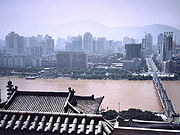
Under the Ming Dynasty (1368–1644) the prefecture was demoted to a county and placed under the administration of Lintao superior prefecture, but in 1477 Lanzhou was reestablished as a political unit.
The city acquired its current name in 1656, during the Qing Dynasty. When Gansu became a separate province in 1666, Lanzhou became its capital.
In 1739 the seat of Lintao was transferred to Lanzhou, which was later made a superior prefecture called Lanzhou.
Lanzhou was badly damaged during the rising of the Gansu Muslims in 1864–1875. In the 1920s and 1930s it became a center of Soviet influence in northwestern China. During the Sino-Japanese War (1937–1945) Lanzhou, linked with Xi'an by highway in 1935, became the terminus of the 3,200 km (2,000 mile) Chinese-Soviet highway, used as a route for Soviet supplies destined for the Xi'an area. This highway remained the primary traffic route of northwestern China until the completion of the railway from Lanzhou to Urumqi, Xinjiang. During the war Lanzhou was heavily bombed by the Japanese.
The city is the seat of a currently vacant Roman Catholic diocese[3] and was previously the center of a vicariate apostolic (Vicariate Apostolic of Northern Kan-Su).[4]
Geography
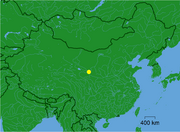
- Area: 14,620 km²
- Elevation: 1,600 m above sea level
- China's northwest geographical center
- More than 20 km of urbanisation along the southern banks of the Yellow River.
- Zonary basin
- Location of mountains, located on the south and north sides of the city:
- Qilian Ranges, Mt. Pingliang and Mt. Kongtong (the most famous in Taoism)
- Rivers:
- The Yellow River flows through from west to east.
Lanzhou is situated on the upper course of the Yellow River, where the river emerges from the mountains. It has been a center since early times, being at the southern end of the route leading via the Hexi Corridor across Central Asia. It also commands the approaches to the ancient capital area of Chang'an (modern Xi'an) in Shaanxi province from both the west and the northwest, as well as from the area of Qinghai Lake via the upper waters of the Yellow River and its tributaries.
Climate and environment
| Lanzhou | ||||||||||||||||||||||||||||||||||||||||||||||||||||||||||||
|---|---|---|---|---|---|---|---|---|---|---|---|---|---|---|---|---|---|---|---|---|---|---|---|---|---|---|---|---|---|---|---|---|---|---|---|---|---|---|---|---|---|---|---|---|---|---|---|---|---|---|---|---|---|---|---|---|---|---|---|---|
| Climate chart () | ||||||||||||||||||||||||||||||||||||||||||||||||||||||||||||
|
||||||||||||||||||||||||||||||||||||||||||||||||||||||||||||
|
||||||||||||||||||||||||||||||||||||||||||||||||||||||||||||
Lanzhou is situated in the temperate zone and enjoys a semi-arid climate (Köppen BSk) with hot summers and cold and dry winters. Diurnal temperature ranges tend to be somewhat large due to the high elevation and aridity. The mean annual temperature is 9.8 °C (49.6 °F), while annual rainfall is 315 millimetres (12.4 in), almost all of which falls from May to October. The winters are so dry that snow is extremely rare.
In regard to air pollution Lanzhou has some of the worst air quality of all cities in China.[5] According to the Blacksmith Institute, Lanzhou is one of the 30 most polluted cities in the world, with its TSP (total suspended particle) rating 247% above that of the Gansu State recommendation. The air quality is so poor that at times one can not see Lanshan, the mountain rising straight up along the south side of the city. At one point, a controversial suggestion was put forward to bulldoze a mountain adjacent to the city, in order to let fresh air in to the bowl where Lanzhou is situated. It was suggested on the premise that the surrounding mountains block a free flow of air in the city. The city is located in a narrow river valley with an unfortunate curve causing it to be hemmed in with no free air flow. Lanzhou is also the home of many factories, including some involved in petroleum processing, and suffers from large dust storms kicked up from the Gobi Desert, especially in the winter and spring.
The reach of the Yellow River at Lanzhou carries a high load of silt, giving the river its characteristic muddy appearance; however water quality in this reach is better than the "fetid outflow that barely passes for water two hours downstream".[6]
| Climate data for Lanzhou (1971-2000) | |||||||||||||
|---|---|---|---|---|---|---|---|---|---|---|---|---|---|
| Month | Jan | Feb | Mar | Apr | May | Jun | Jul | Aug | Sep | Oct | Nov | Dec | Year |
| Average high °C (°F) | 1.7 (35.1) |
6.0 (42.8) |
12.2 (54) |
19.6 (67.3) |
24.1 (75.4) |
27.3 (81.1) |
29.3 (84.7) |
27.9 (82.2) |
22.8 (73) |
16.7 (62.1) |
9.5 (49.1) |
2.8 (37) |
16.7 (62.1) |
| Average low °C (°F) | −10.1 (13.8) |
−6.0 (21) |
0.3 (32.5) |
6.1 (43) |
10.7 (51.3) |
14.3 (57.7) |
16.6 (61.9) |
15.7 (60.3) |
11.4 (52.5) |
5.0 (41) |
−2.1 (28.2) |
−8.3 (17.1) |
4.5 (40.1) |
| Precipitation mm (inches) | 1.4 (0.055) |
2.6 (0.102) |
9.2 (0.362) |
14.7 (0.579) |
33.2 (1.307) |
44.0 (1.732) |
67.0 (2.638) |
73.8 (2.906) |
40.7 (1.602) |
21.3 (0.839) |
2.8 (0.11) |
0.9 (0.035) |
311.6 (12.268) |
| % Humidity | 54 | 49 | 48 | 44 | 48 | 54 | 59 | 63 | 66 | 66 | 60 | 58 | 55.8 |
| Avg. precipitation days | 1.9 | 2.4 | 4.5 | 5.3 | 7.5 | 9.4 | 11.4 | 11.2 | 9.9 | 6.3 | 1.7 | 1.0 | 72.5 |
| Sunshine hours | 155.7 | 179.3 | 195.4 | 224.5 | 245.9 | 234.7 | 244.8 | 241.1 | 191.5 | 186.0 | 174.0 | 151.2 | 2,424.1 |
| Source: China Meteorological Administration | |||||||||||||
Administrative divisions
| Map | ||||||
|---|---|---|---|---|---|---|
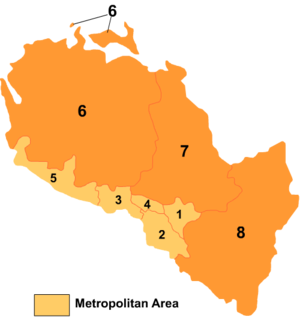 |
||||||
| # | Name | Hanzi | Hanyu Pinyin | Population (2004 est.) |
Area (km²) | Density (/km²) |
| 1 | Chengguan District | 城关区 | Chéngguān Qū | 880,000 | 220 | 4,000 |
| 2 | Qilihe District | 七里河区 | Qīlǐhé Qū | 450,000 | 397 | 1,134 |
| 3 | Xigu District | 西固区 | Xīgù Qū | 320,000 | 385 | 831 |
| 4 | Anning District | 安宁区 | Ānníng Qū | 210,000 | 86 | 2,442 |
| 5 | Honggu District | 红古区 | Hónggǔ Qū | 140,000 | 575 | 243 |
| 6 | Yongdeng County | 永登县 | Yǒngdēng Xiàn | 500,000 | 6,090 | 82 |
| 7 | Gaolan County | 皋兰县 | Gāolán Xiàn | 170,000 | 2,556 | 67 |
| 8 | Yuzhong County | 榆中县 | Yúzhōng Xiàn | 420,000 | 3,362 | 125 |
Economy

Productivity
Since 1949 Lanzhou has been transformed from the capital of a poverty-stricken province into the center of a major industrial area. The GDP per capita of Lanzhou was 25,566 yuan (RMB) (US$3,681) in 2008, ranked no. 134 among 659 Chinese cities.
Natural resources
There is a thermal generating plant supplied with coal from fields in Qinghai. In addition, there is a hydroelectric station at Zhulama Gorge in Gansu, and a large multipurpose dam has been built in the Liujia Gorge on the Yellow River above Lanzhou.[7]
Industry
Main industries include textile mills, rubber, fertilizer plants, oil refinery, petrochemical, machinery, and metallurgical industry.
Gansu has one of the largest oil refineries in the country and Lanzhou itself is the center of the province's petrochemical industry. Lanzhou has a large refinery linked to the fields at Yumen by pipeline. It also manufactures equipment for the oil industry.
Lanzhou has a large textile industry, particularly noted for the production of woolens and leather goods. In addition, Lanzhou produces locomotives and rolling stock for the northwestern railways, as well as machine tools and mining equipment. Aluminum products, industrial chemicals, and fertilizers are produced on a large scale, and there is a large rubber industry. Copper is mined in nearby Gaolan.
Lanzhou has been one of the centers of China's national nuclear power industry since the 1960s.
Industrial zones:
- Lanzhou Economic and Technological Development Zone
- Lanzhou High-tech Industrial Development Zone
Agriculture
Lanzhou is the collecting center and market for agricultural produce and livestock from a wide area.
Transportation
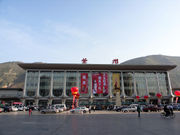
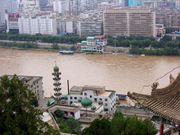
Airlines
- Lanzhou Airport serves as the main airport and is located 70 km north of Lanzhou. Flights from more than 20 cities depart and arrive at the airport.
Railroad
Lanzhou is a major railway hub of western China. It has the following railway connections:
- Longhai Railway to the east (Xi'an, Zhengzhou, Lianyungang), with connection to the main railway of Eastern China supporting direct trains to Beijing, Shanghai etc. This was the first railway to reach Lanzhou (1953).
- Lanxin Railway to the west and northwest (with direct trains to western Gansu and Ürümqi, and further connections to other points in Xinjiang and to Kazakhstan)
- Lanqing Railway to the west and southwest, with direct service to Xining and Lhasa
- A line to the north and northeast, with direct service to Yinchuan and Baotou
Construction of new high-speed passenger-only railway lines is carried out both toward the east (the Xulan Passenger Dedicated Line) and the west (the Lanxin High-Speed Railway).
Lanzhou train station's coordinate is
Highways
- Linked to neighboring provinces
- China National Highway 212
- China National Highway 213
- China National Highway 312
Bus services
- Serves local and provincial areas
Places of interest
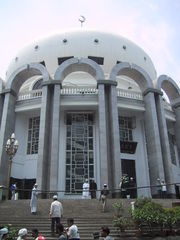
- Gansu Provincial Museum
- Wuquan Mountain
- Baita Mountain
- Xinglong Mountain
- Lutusi ancient government
Elsewhere in Gansu
- Bingling Temple (Yongjing County)
Media
- Gansu People's Press, in Lanzhou, publishes Duzhe, the most widely circulated magazine in the People's Republic of China.
- Lanzhou Radio serves the Lhasa and Lanzhou province regions with news and music.
Culture
The city is the cultural centre of Gansu.
- Chinese opera: Qinqiang Drama
- Cuisine: Lanzhou beef lamian noodles
Colleges and universities
The city is the seat of Lanzhou University, founded in 1909. The National Minorities Institute at Lanzhou and a number of scientific institutes are also located there.In particular, Northwest Normal University has been the key university at the provincial level, which has prepared over 100,000 teachers in schools across the province Gansu.
List
Note: Institutions without full-time bachelor's degree programs are not listed.
National level
- Lanzhou University (兰州大学), founded 1909
Other public institutions
- Northwest Nationalities University (西北民族大学)
- Eastern Gansu University (陇东学院)
- Gansu Institute of Political Science and Law (甘肃政法学院)
- Northwest Normal University (西北师范大学), founded 1902
- Lanzhou University of Technology (兰州理工大学), founded 1919 (formerly Gansu University of Technology)
- Lanzhou Jiaotong University (兰州交通大学), founded 1958
- Gansu Agricultural University (甘肃农业大学), founded 1958
- Lanzhou Medical College (兰州医学院) (Lanzhou Medical Institute)
- Gansu College of Traditional Chinese Medicine (甘肃中医学院)
- Lanzhou Commercial College (兰州商学院) (Lanzhou Business Institute)
- Gansu Political Science and Law Institute (甘肃政法学院)
- Lanzhou Niuroumian Cultural Research Institute (兰州牛肉面文化研究所)
- Lanzhou City University (兰州城市学院)
- Tianshui Normal University (天水师范学院)
- Gansu Lianhe University (甘肃联合大学)
Healthcare
- Lanzhou Heavy Ion Cancer Treatment Center, joint venture by Sheng De Group, the city government and Chinese Academy of Sciences' Institution of Modern Physics
According to the provincial health bureau, about 42,000 people die of cancer every year in Gansu, accounting for 25 percent of the province's overall deaths. More than 1 billion yuan (146 million U.S. dollars) is spent annually on treating cancer in the province.
International relations
Twin towns — Sister cities
Lanzhou is twinned with:
See also
- Dunhuang
- White Pagoda Hill
References
- ↑ Xian Xiaowei, Zhang Linyuan, Ai Nanshan and Wihelm Wohlke, On the relation between the evolution of natural environment and human factors and the development of urban settlement—Take the Lanzhou Valley Basin as an examples, Springerlink vol.1,no.1 (1991)
- ↑ C.Michael Hogan, Silk Road, North China, the Megalithic Portal, ed. Andy Burnham
- ↑ Archdiocese of Lanchow at catholic-hierarchy.org
- ↑ Vicariate Apostolic of Northern Kan-Su at Catholic Encyclopedia
- ↑ Gansu Daily, [reports lowest standing of 84 Chinese cities surveyed]
- ↑ Yellow River Pollution Is Price of Economic Growth, Rob Gifford. NPR, Jan. 6, 2008
- ↑ Liujiaxia Gorge and Bingling Temple
External links
- Lanzhou government website
- Lanzhou travel guide from Wikitravel
|
|||||||||||||||
|
||||||||||||||||||||||
|
|||||
|
|||||||
